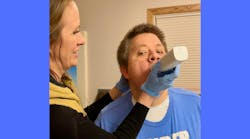One size does not fit all: Introducing Samba toothbrush
There are many ways to prevent oral diseases, such as nutrition, hydration, avoiding tobacco, limiting sugary and acidic foods, and of course, toothbrushing. However, toothbrushing is challenging for some individuals, through no fault of their own.
As dentistry moves more toward precision medicine, we're recognizing the importance of personalization. Instead of a one-size-fits-all approach, patients and dental providers have a wealth of tailored products to choose from and recommend. Our approach should lean into suggesting devices, instruments, and medicaments that meet each patient’s specific needs.
In an era of many product options, we are constantly challenged to find the right device for simple toothbrushing in a certain subset of the patient population. Those with intellectual, developmental, and neurological disabilities have unique needs that have been not fully addressed. In this subset of patients, 88% suffer from dental problems.1
It’s thrilling that the oral hygiene company Curaden made the commitment that every person, no matter what their ability, will have a brush to meet their needs. Curaden has designed toothbrushes for more than 40 years, and they know that the mouth is the gateway to the rest of the body.
The company has introduced a groundbreaking innovation revolutionizing the lives of patients with disabilities that promises significant improvements in their health and well-being. Their solution may also alleviate the burden on caregivers who struggle to help their loved ones or patients maintain their hygiene. With Samba, caregivers can potentially experience reduced stress and heightened confidence, reassured that their efforts are yielding positive results.
Introducing Samba tootbrush
Samba is a one-of-a-kind power brush that uses a combination of oscillations with both low and high frequencies, moving 12,900 soft bristles covering 36 surfaces simultaneously in just one minute. Staying true to tailored and customized care, Curaden understands that no two people and mouths are the same. That’s why they designed the brush head with a flexibility to adapt to any mouth by having a 6-degree adjusting swing. Regular brush heads are about 20 mm wide, which makes it almost impossible to clean the space between teeth.
The bristles in the Samba are grouped in 1.8 mm-wide columns, allowing them to deep clean differently. Samba showcases a configuration of 17 microbrushes, each equipped with 790 gentle bristles meticulously designed to apply just the right pressure and eliminating the need for guesswork.
The toothpaste is applied in the small dots in the middle and at the end of each side and it spreads as the brush head moves along the teeth. After 30 seconds per arch, all surfaces are clean. This brush is rechargeable and lasts almost a month, and it’s water-resistant, allowing for use in the shower. As with all toothbrushes, the recommendation is to change the toothbrush head every three months. The Samba comes with a one-year warranty.
So, does it live up to the hype? Yes! I went without brushing for two excruciating days. I disclosed, then put three small dots of toothpaste in the middle and on each side of the brush, and my results were remarkable. If it isn’t a resounding yes for you and your patient after purchase, there is a 60-day money back guarantee.
The Samba brush was invented to remove obstacles and empower individuals with differing abilities. It has also provided dental professionals with a valuable solution for specific patient needs. People are taking note. Samba was awarded one of the best inventions of 2023 by Time magazine. Everyone deserves to have the tools to improve their oral health and ultimately their entire body.
Reference
1. Morgan JP, Minihan PM, Stark PC, et al. The oral health status of 4,732 adults with intellectual and developmental disabilities. J Am Dent Assoc. 2012;143(8):838-846. doi:10.14219/jada.archive.2012.0288


